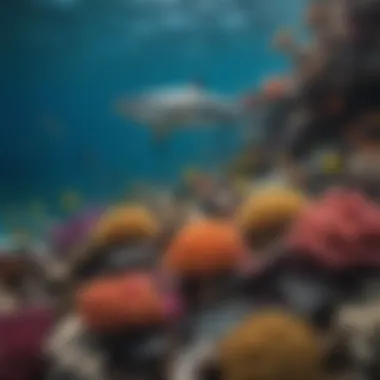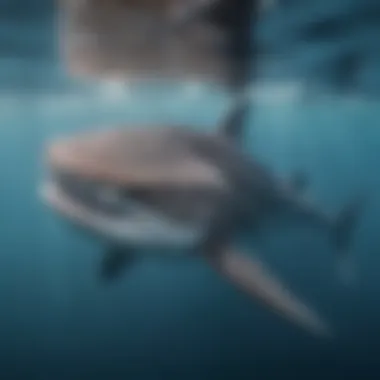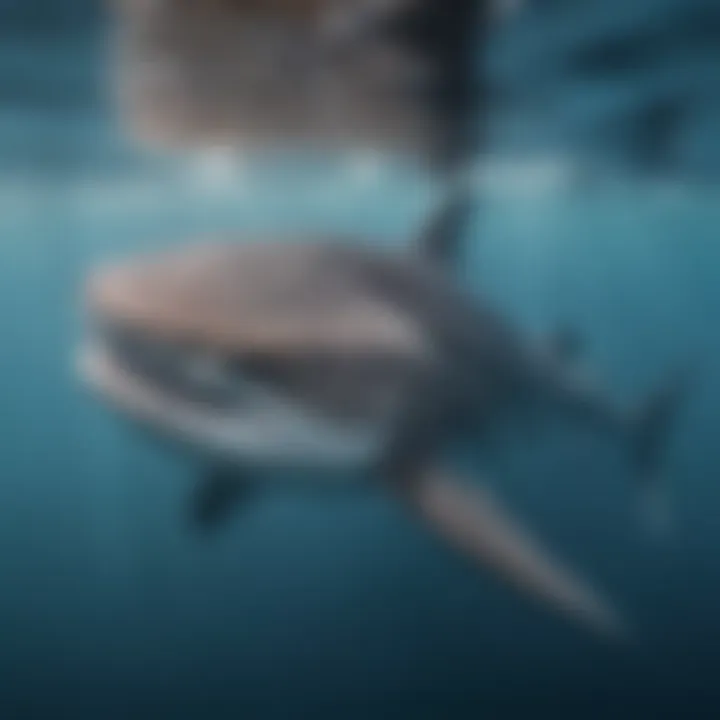Exploring Sharks: Roles, Traits, and Conservation


Intro
The ocean, vast and mysterious, is home to a myriad of creatures that evoke both intrigue and fear. Among them, sharks stand out as some of the most misunderstood and crucial marine life. These ancient predators, with their sleek bodies and keen instinct, are more than just athletes of the sea; they play a significant role in the health of our oceans.
While sharks are often painted in a fearsome light, the truth thanks to recent research is far more nuanced. To truly appreciate these majestic animals, it is essential to examine their biology, behavior, and the environment they inhabit. This exploration helps us unravel their pivotal role in marine ecosystems, and it sheds light on the pressing need for their conservation amidst growing environmental threats.
We'll dive into the fundamental techniques and skills related to understanding these creatures, the necessary equipment for observing them, and how you can participate in conservation efforts. Whether you're a seasoned ocean enthusiast or just diving into this subject for the first time, there's much to uncover in the complex world of sharks.
Intro to Sharks
Understanding sharks is crucial not only for marine biology but for grasping our planet's ecological balance. These creatures have roamed the oceans for over 400 million years, evolving into a myriad of species with unique adaptations. Their existence serves as a barometer for ocean health. The decline in shark populations often signals broader ecological turmoil.
Sharks play a pivotal role in keeping the marine ecosystem in harmony, helping regulate species populations and maintain the health of coral reefs and seagrass beds. By taking time to explore the intricate world of sharks, we begin to see how our actions directly impact these creatures and, in turn, the oceans.
Defining Sharks
Sharks belong to the class Chondrichthyes, which includes rays and skates, distinguished primarily by having a skeleton made of cartilage instead of bone. The most notable feature is their streamlined body, usually covered in dermal denticles, which facilitates efficient swimming. They can be found in various shapes and sizes, ranging from the diminutive dwarf lanternshark to the formidable whale shark.
There's no denying that sharks are formidable predatory fish, yet their behavior and characteristics are far more intricate than most realize.
Some defining traits of sharks include:
- Apex predators: Sharks sit at the top of the food chain, playing a significant role in controlling the populations of prey species.
- Unique reproductive strategies: Many sharks exhibit remarkable reproductive adaptations, such as ovoviviparity, where eggs hatch inside the female.
- Sensory adaptations: Sharks possess an exceptional range of senses, including the ability to detect electromagnetic fields.
Historical Overview
The history of sharks is a captivating tale of survival against overwhelming odds. These ancient creatures have outlived massive extinction events. Paleontologists have documented shark-like fossils dating back to the late Silurian period, making them one of the planet's oldest living species.
Throughout history, sharks have faced various challenges, both natural and human-induced. Despite their resilience, the advent of industrialized fishing methods in the 20th century began to pose significant threats. Their portrayal in media, often leading to misinformed fears, overshadowed their contributions to marine ecosystems. A deeper historical context reveals the importance of understanding sharks—not as villains in our oceans, but as vital members of the marine community.
"Sharks do not just inhabit the ocean; they help shape it. Their long history is a testament to their significance in the marine world."
Given the historical interactions between humans and sharks, it becomes even more critical to acknowledge the role they play in our oceans and the urgent need for protective measures in response to escalating threats. Through a historical lens, we can appreciate the intricacies of their existence and the shared responsibility we have in safeguarding these magnificent creatures.
Diversity of Shark Species
The realm of shark diversity is not just a catalog of species; it is a vital thread in the intricate tapestry of marine ecosystems. From the ocean's shallow coastal regions to the mysterious depths of the earth's seas, sharks come in a remarkable variety of shapes, sizes, and adaptations. Understanding this diversity goes beyond mere classification. It sheds light on the ecological roles sharks play and the evolutionary paths they have taken. Each species contributes to the balance of marine life, affecting everything from prey populations to habitat health.
Common Shark Species
Common sharks include those frequently spotted by divers and marine enthusiasts. Some of these species such as the great white shark, tiger shark, and hammerhead shark have become icons in popular culture, often misrepresented but nonetheless significant in their habitats.
- Great White Shark: Known for its size and hunting prowess, this apex predator maintains the balance of marine ecosystems by preying on marine mammals and fish.
- Tiger Shark: Distinguished by its unique striped pattern, this opportunistic feeder eats a wide range of prey, from fish to birds. Its adaptability is a testament to its success in various marine environments.
- Hammerhead Shark: Unique for its distinctly shaped head, this species benefits from enhanced sensory perception, allowing it to detect prey efficiently in the waters it inhabits.
These species not only contribute to biodiversity but also attract tourism, driving awareness and conservation efforts.
Rare and Unique Sharks
Not every shark is as famously recognized as the great whites or tiger sharks. Some species are so rare that they seem more like ghosts of the ocean, evoking a sense of mystery about their existence. Examples include the megachasma pelagios, commonly referred to as the basking shark, and the Etmopterus perryi, known as the lanternshark.
- Basking Shark: Second only to the whale shark in size, the basking shark is known for its gentle feeding habits. It filters plankton from the water, displaying the delicate side of a creature typically viewed as ferocious.
- Lanternshark: This small, bioluminescent shark remains largely unseen, residing in deep waters where it uses its light to communicate and hunt.
It’s essential to recognize that these unique sharks face severe threats from habitat degradation and climate change, emphasizing the need for dedicated conservation efforts. As our understanding of these fascinating species grows, the importance of protecting their habitats becomes clearer, paving the way for sustainable marine practices that could ensure their survival.
Anatomy and Physiology
Understanding the anatomy and physiology of sharks is crucial for grasping their role in marine ecosystems. Sharks are marvels of evolution, possessing adaptations that have allowed them to thrive in a variety of habitats. Their unique physical features not only contribute to their success as predators but also play vital roles in maintaining the ecological balance of the oceans.
Physical Characteristics
Sharks exhibit a fascinating array of physical characteristics that set them apart from other marine creatures. One of the most distinctive features is their streamlined bodies, which enable efficient movement through water. This hydrodynamic design allows them to swim swiftly, making sharp turns and sudden bursts of speed that are essential for capturing prey.


- Skin Texture: The skin of sharks is covered in tiny, tooth-like structures called dermal denticles. These enhance their swimming capabilities and reduce drag, allowing for smoother movement and increased speed.
- Fins: Sharks have varying fin shapes, sizes, and placements. The pectoral fins help with lift and steering, while the dorsal fins can aid in stabilization, particularly when maneuvering at high speeds.
- Jaw Structure: Sharks possess a unique jaw structure that allows them to open their mouths wide and extend their teeth outward, a trait particularly pronounced in species like the great white shark.
These features not only aid in hunting and survival, but also provide sharks with the ability to occupy various niches in the marine environment, from coastal zones to the deep sea.
Senses and Sensory Organs
Sharks are equipped with a remarkable set of sensory organs that enhance their ability to detect prey and navigate their surroundings. The effectiveness of these senses is paramount for their survival, especially in vast and often murky ocean waters.
- Acute Smell: Sharks have an extraordinary sense of smell, capable of detecting blood from miles away. This ability allows them to locate injured or distressed animals, which can serve as an easy meal.
- Electroreception: One of the standout features of sharks is their capacity to sense electrical fields through specialized organs called Ampullae of Lorenzini. This allows them to detect the subtle electric signals emitted by other marine animals, particularly useful for hunting hidden prey.
- Vision: Contrary to common belief, sharks have excellent vision, optimized for low-light conditions. Their eyes can identify contrast and movement rapidly, which is crucial for spotting potential food.
- Lateral Line System: This system helps sharks to detect vibrations and movements in the water, which plays a significant role in their hunting and navigation. It’s akin to having an underwater radar system.
The anatomical and physiological adaptations of sharks reflect millions of years of evolution, finely tuning them to their roles as apex predators in the oceans.
Through these remarkable physical traits and heightened senses, sharks are not just survivors; they are integral components of their ecosystems. They control prey populations, contributing to the overall health of marine environments. Understanding how anatomy and physiology work together in sharks gives us greater insight into their importance and their ongoing conservation.
Behavioral Ecology
Understanding the behavioral ecology of sharks is crucial in grasping their role as apex predators in marine ecosystems. This area examines how sharks interact with their environment, other species, and how their behaviors influence ecological dynamics. It shines a light on the survival tactics these creatures employ, their adaptability to changing environments, and the intricate relationships they maintain within their habitats. Through this lens, one can appreciate the sophistication of sharks beyond their sometimes fearsome reputation.
Feeding Habits
Shark feeding behaviors vary dramatically between species, reflecting a diverse set of adaptations that enable them to thrive in varied marine environments. From the massive whale shark filtering tiny plankton to the formidable great white shark hunting seals, these predatory strategies showcase a fascinating range of techniques.
- Ambush Predation: Many species such as the great white use stealth and speed to ambush their prey. They often hunt by swimming beneath seals and launching upwards, a technique known as breaching.
- Benthic Feeding: Species like the nurse shark utilize their agile mouths to forage along the ocean floor, sucking in crustaceans and small fish.
- Scavenging: Some sharks, including the hammerhead, exhibit scavenging behavior, feeding on dead fish. This adaptation allows them to thrive even when active hunting opportunities are scarce.
Understanding the nuances of shark feeding habits enables researchers to map out food webs in their habitats, highlighting the impact that these predators have on the health of marine ecosystems.
Reproductive Strategies
Shark reproduction is as varied and complex as their feeding behaviors. They exhibit a range of reproductive strategies that can influence their survival.
- Oviparous species lay eggs, providing a safe developmental environment for embryos in hard cases or mermaids’ purses. This allows for a number of fertilized eggs to be safeguarded against predators.
- Viviparous reels, like the bull shark, give birth to live young, maintaining a direct nutrient supply through a placental connection, enhancing juvenile survival rates in nutrient-rich environments.
- Aplacental Matrotrophy: Not all sharks follow conventional reproductive paths. For instance, the sand tiger shark embryos engage in intrauterine cannibalism where the strongest embryos consume their weaker siblings. This practice highlights survival of the fittest right from the start, ensuring that the offspring that are born are resilient.
By examining these diverse reproductive strategies, we get a clearer picture of how sharks have adapted to varying environmental challenges and their prolific ability to maintain population levels, crucial for their roles in their respective ecosystems.
Social Structures
Shark social structures differ significantly between species, often shaped by environmental conditions and resource availability. Contrary to popular belief, many sharks are not solitary creatures but engage in complex social interactions, often dictated by the need for cooperation during feeding.
- Schooled Behavior: Some species, like the blacktip reef shark, are known to form schools, which may help in hunting and evading predators. When in groups, they often exhibit synchronized swimming patterns that confuse prey.
- Territorial Displays: Male sharks may establish territories during mating seasons, exhibiting displays to attract females or ward off rivals. Their elaborate behavioral displays during this period underscore the importance of territory in reproductive success.
- Communal Living: Sharks such as the lemon shark display a fascinating level of sociality. Researchers have noted that they engage in cooperative behaviors, such as group hunting, which enhances their efficiency and success rates.
These social behaviors contribute to the balance within marine environments and highlight the importance of understanding the complex relationships sharks maintain with each other and their surroundings.
As we delve deeper into the behavioral ecology of sharks, it becomes increasingly evident that these magnificent creatures possess intricate patterns of life that are essential to the marine ecosystems they inhabit.
Sharks in Their Habitats
Understanding where sharks thrive is key to grasping their ecological roles. Different shark species have evolved to inhabit specific marine environments, from bustling coastal waters teeming with life to the sheer vastness of the open ocean and the darker depths of the deep sea. Each habitat presents its own set of conditions, influencing the behavior and health of shark populations.
Marine Environments
Coastal Waters
Coastal waters serve as fundamental habitats for many shark species. These areas are rich in nutrients, making them ideal breeding grounds and feeding zones. Sharks like the tiger shark and hammerhead favor these shallower waters because they provide abundant prey. The key characteristic of coastal habitats is their biodiversity, which provides various food sources for sharks. Such ecosystems also offer shelter and a chance for young sharks to avoid larger predators.
However, with this richness also comes vulnerability. Coastal regions are often under threat from human activities such as pollution and coastal development, which can devastate the habitats sharks rely on.
Open Ocean
The open ocean, characterized by its metric spaces and currents, presents unique challenges and advantages for sharks. Here, species like the great white shark and the mako are known to roam, showcasing their impressive migratory behavior. This environment offers wide-ranging opportunities for feeding on larger prey and is essential for certain species' life cycles. Its key characteristic is the vastness; it allows sharks to utilize a range of temperatures and depths.
Yet, despite the advantages, sharks in the open ocean also face threats from overfishing and climate change impacting prey availability. Their travel patterns can lead them into precarious situations near fishing vessels, underscoring the disadvantage of this seemingly boundless habitat.
Deep Sea


The deep sea represents one of the most enigmatic and least understood habitats for sharks. Species like the goblin shark and the frilled shark inhabit these dark waters, demonstrating remarkable adaptations to extreme conditions, such as bioluminescence and elongated bodies. The unique feature of the deep sea is its cold temperatures and high pressure, environments that challenge superficial marine life but can offer safety from human activities.
Some sharks in these depths have evolved to exploit prey that other predators can't reach, leading them to be less vulnerable to overfishing. However, the deep sea is still impacted by issues like climate change and ocean acidification, which can alter their habitats and prey relationships.
"Sharks are an integral part of marine systems, with their habitats directly influencing their behavior, health, and interactions with other marine life."
Role in Ecosystems
Sharks are more than just apex predators; they are pivotal to marine ecosystem balance. By regulating prey populations, they help maintain the health of coral reefs and ensure that fish populations remain stable. The loss of sharks can lead to unchecked growth of prey species, ultimately resulting in ecological instability. Understanding the role sharks play in their habitats underscores the importance of their conservation. This connection is not only crucial for marine health but also for human communities that depend on these ecosystems for their livelihood.
Threats to Shark Populations
Understanding the threats to shark populations is crucial for their preservation and management. This section highlights the primary dangers sharks face, including overfishing, habitat destruction, and the profound impacts of climate change. Each of these factors not only jeopardizes the survival of individual species but also disrupts the intricate balance of marine ecosystems. Given their role as apex predators, any decline in shark populations can lead to unpredictable effects throughout the food web, impacting other marine life and, ultimately, human communities.
Overfishing and Bycatch
Overfishing is often the first monster that comes to mind when one discusses threats to sharks. For many, the lure of shark meat and fins can make for a tempting catch. Shark fin soup, a delicacy in some cultures, drives an insatiable market. This demand has led to more than 100 million sharks being killed each year, often through methods that are indiscriminate and brutal. Many sharks fall victim to bycatch—being caught unintentionally in nets or on lines meant for other species. This unintended catch often results in a high mortality rate for sharks, as they may be released injured or dead after being caught.
Some fishermen use longlines that span miles, hooking numerous pelagic species, yet allowing sharks no chance of escape. The unsustainable harvesting of shark populations not only threatens their survival but also poses a significant threat to the stability of the ecosystems they inhabit.
Habitat Destruction
Another grave threat to sharks comes not just from the water but from the land. Coastal development, pollution, and destructive fishing practices severely affect shark habitats. Coastal waters, where juvenile sharks usually grow and thrive, are increasingly becoming hotspots for human activities, including resort developments and industrial sites. Mangroves and seagrasses, critical habitats for sharks, are being destroyed at alarming rates.
Furthermore, pollution from urban runoff introduces toxins into marine environments, further jeopardizing shark health and their habitats. The intricate home of coral reefs is also deteriorating, leading to a loss of biodiversity and a decrease in food sources for sharks.
Sharks rely on these habitats not only for breeding and nursery grounds but also for hunting. Without these vital ecosystems, the health of shark populations will dwindle, revealing a dark reality where some species become scarce or even face extinction.
Climate Change Effects
Climate change looms large as a threat to marine life, and sharks are no exception. As ocean temperatures rise, their natural habitats change, forcing sharks to adapt or migrate. The warming water affects prey distribution and abundance, creating a ripple effect across the food chain. Moreover, many sharks rely on specific conditions; changes in these habitats may lead to reduced reproductive rates or even compromised survival.
Ocean acidification, a byproduct of increased atmospheric CO2 levels, impacts the marine ecosystems significantly, affecting the availability of food sources. Sharks’ physiological responses to these environmental shifts may not be swift enough, leading to a dire situation. Studies are already indicating shifts in shark migrations and daily activities, which complicate conservation efforts even further.
"The future of sharks is inextricably linked to the health of our oceans. Without action to address overfishing, habitat destruction, and climate change, we risk losing species that have existed for millions of years."
In summary, the multifaceted threats facing shark populations demand a concerted effort by not just scientists and policymakers, but by each and every one of us. By understanding these dangers, we equip ourselves with the knowledge necessary for effective conservation efforts that safeguard these majestic creatures.
Conservation Efforts
Conservation efforts play a pivotal role in ensuring the survival of shark populations across the globe. Sharks, often misunderstood and wrongly vilified, are crucial components of marine ecosystems. Their conservation not only secures their future but benefits the entire oceanic environment. The decline of shark species can lead to severe imbalances, affecting not only marine life but also human communities reliant on healthy oceans. Thus, understanding and engaging with conservation strategies is essential for anyone invested in the future of our marine ecosystems.
Global Initiatives
At the international level, various organizations and agreements have aimed to protect sharks and their habitats. For instance, the Convention on International Trade in Endangered Species (CITES) plays a significant role by regulating trade in shark species listed as threatened. One striking example of a global initiative is the Shark Protection Act, which has gained traction in many countries. This act focuses on banning practices like shark finning, which involve removing fins from sharks and discarding the fish while still alive, often resulting in a slow and painful death.
In addition to legal frameworks, campaigns by organizations like Wildlife Conservation Society and Oceana have raised awareness and educated the public about the threats faced by sharks. Such efforts aim to garner support for sustainable fishing practices.
Many of these initiatives are bolstered by scientific research, which provides crucial data about shark populations and their ecological roles. Collaboration among nations, researchers, and fisheries is essential in developing best practices that help to protect sharks while respecting the livelihoods of those who depend on fishing.
"Sharks are not just predators; they are indicators of the health of our oceans. Protecting them is protecting our future."
Community-Based Conservation
One interesting avenue is the community-based conservation model, which emphasizes the involvement of local communities in shark conservation. By engaging those who rely on marine resources for their livelihoods, conservation efforts can be tailored to the specific needs and realities of those communities.
For example, in places like the Bahamas, community-led initiatives have successfully created marine protected areas, where fishing practices are regulated to ensure sustainable populations of sharks. This not only aids in shark recovery but also supports local tourism initiatives, effectively turning sharks into a financial asset rather than a liability. Tourists seeking shark diving experiences can bring much-needed revenue to local economies, incentivizing the protection of these creatures.
Moreover, educational programs are vital. Teaching community members about the ecological importance of sharks fosters a culture of respect and conservation. Many grassroots organizations work tirelessly to provide resources and training for community members, empowering them to become advocates for their local marine environments.
While challenges are many, community-based conservation proves that when local people are invested in preserving their natural heritage, real change can happen.


Sharks and Human Interaction
Understanding the dynamics of sharks and human interaction is crucial in grasping the broader implications of these magnificent creatures in our lives. Sharks, often viewed through the prism of fear and mystery, play multifaceted roles that extend beyond mere predatory behavior. Connecting with their true nature can pave the way for more informed conservation efforts and appreciation. Their interaction with humans offers significant insights into cultural beliefs, tourism economics, and biodiversity awareness, making this topic both complex and rich for exploration.
Cultural Significance
Sharks hold an intrinsic cultural significance across a variety of societies. From ancient myths to modern-day literature, there is a myriad of stories woven around these creatures that reflect our collective fascination and fear. In many island communities, sharks are seen as ancestral beings or guardians, embodying both power and protection. For instance, in Hawaiian culture, the shark goddess Kanaloa symbolizes the importance of respecting nature and the sea.
Additionally, literature like Ernest Hemingway’s The Old Man and the Sea brings the shark into the human narrative, illustrating struggle, respect, and the quest for understanding. Such portrayals foster a deeper connection with sharks, challenging the sensationalist images often propagated by media.
On a more practical level, sharks figure prominently in the world of art and merchandise. Whether it be clothing branded with fierce shark graphics or decorative pieces inspired by their sleek forms, these representations serve dual purposes. They promote awareness while celebrating the aesthetic presence of sharks in a way that resonates with various audiences. The rise of documentaries and films showcasing these apex predators also enkindle curiosity and reverence for their role in the oceans.
Shark Tourism
Shark tourism represents a significant niche in the travel industry, reflecting an increasing desire among adventure seekers to interact with these fascinating species in their natural habitats. Destinations like the Bahamas and South Africa thrive on shark diving activities, offering tourists an adrenaline rush mixed with an educational experience.
However, there are underlying benefits and concerns associated with this sector:
- Economic Incentives: Shark tourism can provide much-needed financial resources to local economies. Communities involved in shark-related tourism often find sustainable ways to benefit from conservation rather than exploitation. Each diver or snorkeler comes not just to encounter sharks, but also contributes to the livelihood of local fishermen, guides, and businesses.
- Conservation Advocacy: The increased visibility of sharks can lead to heightened awareness and a conservationist mindset among the public. Engaging in responsible tourism, like shark diving, encourages participants to learn about marine ecology and the importance of preserving habitats.
- Ethical Considerations: Despite its benefits, shark tourism must tread lightly to avoid causing harm to these vulnerable creatures. Responsible practices are essential. Tour operators should adhere to strict guidelines to minimize stress on shark populations and ensure their well-being.
In sum, human interaction with sharks encompasses cultural, economic, and ethical dimensions that must be navigated with care. Sharks do not exist in isolation; they are a vital part of a vast ecosystem that deserves respect and protection. While encountering these creatures can ignite a passion for marine conservation, it is the stories we tell and the experiences we share that will ultimately shape the future of sharks and their habitats.
Research and Future Directions
As we delve into the intricate world of sharks, understanding Research and Future Directions is paramount. It informs our responses to the myriad challenges these creatures face, enhances our appreciation of their ecological roles, and ensures informed conservation strategies moving forward.
The journey of shark research is like peeling an onion; each layer reveals intricate complexities and new understandings. It’s not merely about data collection. This field of study aids in identifying critical areas where targeted efforts can bring about tangible changes, ensuring that sharks continue to thrive instead of becoming distant memories.
Emerging Research Areas
Shark research has expanded into several exciting areas that focus on both the biological and ecological aspects of these creatures. Here are a few of them:
- Genomic Studies: Understanding the genetic makeup of various shark species can lead to discoveries about their adaptive traits, evolution, and potential vulnerabilities.
- Behavioral Ecology: Observations of shark behavior in their natural habitat help to decipher their social structures and interactions, revealing the intricacies of how they communicate and thrive.
- Migration Patterns: Tracking the movements of sharks helps scientists ascertain their migratory routes, which is crucial for effective conservation policies. Understanding where they go and why can drive global conservation efforts.
- Impact of Climate Change: Evaluating how shifting ocean temperatures affect shark populations is a pressing need. Research in this area not only highlights current challenges but also helps predict future scenarios.
These areas of research are not simply academic; they hold the potential for actionable insights that could steer conservation actions and public policy, thus shaping a more sustainable future for sharks.
The Role of Technology
Technology plays a pivotal role in modern shark research, providing tools and methodologies that were unimaginable just a few decades ago. The integration of technological advancements marks a significant shift in how we study these marine predators.
- Satellite Tracking: Using GPS and satellite tags allows researchers unprecedented access to the underwater travels of sharks. This real-time data can illuminate migratory patterns and habitat usage.
- Drones: The use of drones for aerial surveys gives researchers a bird's-eye view of shark populations, assisting them in assessing numbers and health without disturbing the natural behaviors of these animals.
- Environmental DNA (eDNA): An innovative technique that enables scientists to gather genetic material from the water itself, helping them to identify species presence without the need for physical captures. This method is efficient and less invasive, ensuring a higher degree of accuracy in measurements of shark biodiversity.
- Artificial Intelligence: AI can analyze vast amounts of data rapidly, helping researchers detect patterns in shark behaviors or predict population trends that facilitate timely interventions.
Through the lens of technology, researchers can now gather extensive data, analyze it more effectively, and enhance their understanding of sharks within their ecosystems.
"By advancing our research methodologies and employing cutting-edge technology, we can ensure that the importance of sharks, and their contribution to marine ecosystems, is not only recognized but actively preserved for future generations."
In summary, as we look ahead, the intersection of emerging research areas and technology will shape the future of shark conservation efforts. The sheer depth of what remains to be explored is staggering, and it reinforces the necessity of ongoing support for research initiatives. Understanding sharks is not just an academic endeavor; it’s a step towards securing the health of our oceans.
Epilogue
The significance of sharks and their role in marine ecosystems cannot be overstated. In this article, we’ve taken a comprehensive journey through the diverse realms that encompass these remarkable creatures. Sharks are not just mere symbols of the ocean; they represent intricate biological designs and play pivotal parts in maintaining the balance of marine life.
Summarizing Key Points
Through our exploration, several key elements have been illuminated:
- Diversity: Sharks come in various shapes and sizes, from the modest dogfish to the grand whale shark. Their adaptations have allowed them to thrive in different habitats.
- Anatomical Features: The anatomy of sharks is finely tuned to their predatory lifestyle. Their unique physiological traits, such as their acute sense of smell and specialized teeth, place them at the top of marine food chains.
- Behavioral Ecologies: Understanding their behavior—be it feeding or reproductive strategies—sheds light on their adaptability and survival tactics in changing environments.
- Ecological Roles: As apex predators, sharks regulate the populations of other marine species, thereby helping to sustain the health of oceanic ecosystems.
- Threats and Conservation: The pressures sharks face from human activities, including overfishing and habitat loss, highlight an urgent need for conservation efforts.
In synthesizing this information, we find that sharks are not simply fearsome hunters but crucial components of marine ecosystems, deserving our respect and protection.
The Importance of Sharks
Concluding our discussion, it's important to recognize why sharks matter beyond their ecological roles. They are indicators of ocean health; a decline in shark populations often signals larger environmental issues. Moreover, sharks fascinate humans, inspiring countless cultural narratives, researches, and even eco-tourism activities.
To frame it plainly, sharks aren’t just integral to their natural habitats; they also affect economies, communities, and cultures. Ignoring their plight equates to jeopardizing both the marine environment and the very fabric of fishing cultures worldwide.
"Sharks are more than just the beast of the ocean; they are its guardians. We ought to learn from their place in nature rather than fear them."
Whether one seeks thrills through shark diving or aims to conserve them through activism, the underlying message is crystal clear: understanding, respecting, and protecting sharks is crucial for the future of our oceans.







